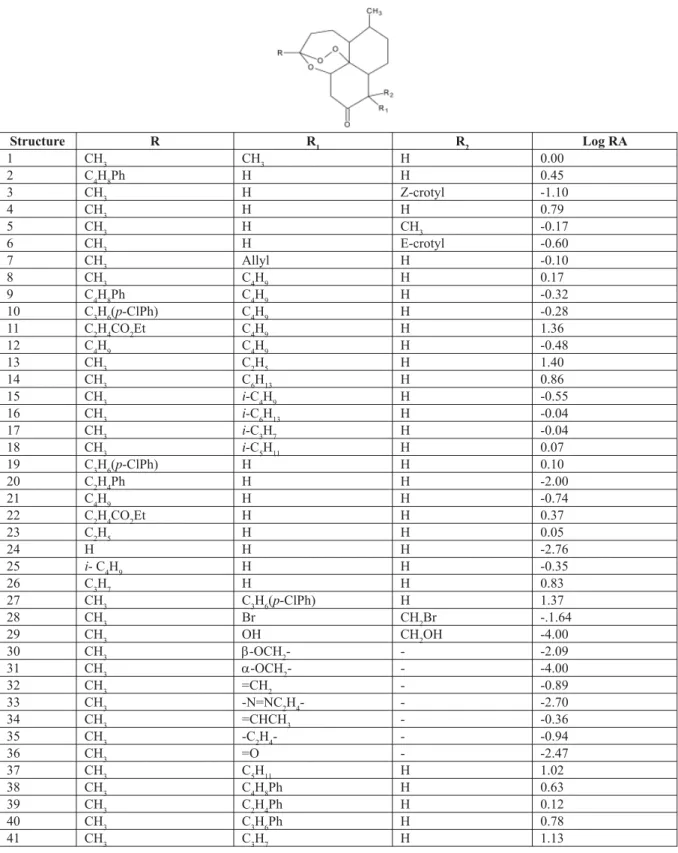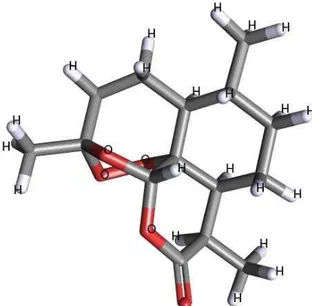45
Calculation of Quantitative Structure-Activity Relationship Descriptors
of Artemisinin Derivatives
Jambalsuren Bayarmaa
1and Vladimir Frecer
21Department of Biochemistry and Bioorganic Chemistry, Faculty of Biology, National University of Mongolia
E-mail: bayarmaa_j@biology.num.edu.mn
2Area of Pure and Applied Chemistry, International Center for Sciense and High Technology-UNIDO,
Trieste, Italy E-mail: vladimir.frecer@ics.trieste.it
Abstract
Quantitative structure-activity relationships are based on the construction of predictive models using a set of known molecules and associated activity value. This accurate methodology, developed with adequate mathematical and computational tools, leads to a faster, cheaper and more comprehensive design of new products, reducing the experimental synthesis and testing on animals. Preparation of the QSAR models of artemisinin derivatives was carried out by the genetic function algorithm (GFA) method for 91 molecules. The results show some relationships to the observed antimalarial activities of the artemisinin derivatives. The most statistically signifi cant regression equation obtained from the fi nal GFA relates to two molecular descriptors.
Key words: molecular model, descriptor, QSAR technique, artemisinin derivatives
Introduction
Malaria is one of the most serious parasitic diseases in the world. There are millions of acute cases of malaria each year globally, resulting in more than one million deaths. The clinical disease caused by Plasmodium falciparum is widely distributed and entrenched in areas of the world where climates are suitable for its transmission. The present level of annual global malaria incident consisted of about 500 million, 350 million in the African region and 125 million in the South East Asian region. Deaths due to malaria are occurring in increasing numbers because of frequent failure of the conventional treatments using drugs such as chloroquine, mefloquine and sulfadoxine-pyrimethamine, against P. falciparum, the populations of which have developed a high degree of resistance.
Combination therapies with formulations containing an artemisinin compound have emerged as a more reliable treatment option. Artemisinin is naturally formed in Artemisia annua L (sweet wormwood). This herb of the Asteraceae family has been used for treatment of fever and malaria in China over many centuries. Additional names found in China for artemisinin are qinghaosu and huanghuahaosu.
Artemisinin and its derivatives are only the group of compounds that is still effective against drug-resistant P. falciparum strains, and has the ability to quickly reduce parasite level (Krishna, 2004). From the other side, it has short plasma half-life, limited bioavailability, poor solubility in oil and water, and the low yield from natural sources (Woodrow, 2005). These reasons prompted to develop new chemotherapeutic artemisinin derivatives. By the chemical modifi cation of artemisinin at the position of C10 semisynthetic derivatives as artesunate, artemether, artelinic acid and dihydroartemisinin were produced, which have more antimalarial activities in vitro than artemisinin itself (Pinheiro, 2003). Many derivatives have been synthesized using dihydroartemisinin by adding different radicals on its rings. But, the development of a new drug is a very long and expensive process. To overcome these diffi culties scientists start to use a variety of computational methods to identify novel compounds, design compounds with increased selectivity, effi cacy and safety and develop compounds into clinical trial candidates. One of these methods is the Quantitative Structure-Activity Relationship (QSAR) technique. The present work is related to the design of a new antimalarial active artemisinin analog.
Methods
The physical properties of drugs dictate their biological activity. Use of descriptors of physicochemical properties allow for the application of mathematical models to analyze and predict drug activity. The physicochemical properties, which include parameters to account
for atomic charges, topology, electronic properties and steric effects are determined by computational methods.
Results of calculation
A. Preparation of the QSAR models
In this field we use ArgusLab software
Structure R R1 R2 Log RA
1 CH3 CH3 H 0.00
2 C4H8Ph H H 0.45
3 CH3 H Z-crotyl -1.10
4 CH3 H H 0.79
5 CH3 H CH3 -0.17
6 CH3 H E-crotyl -0.60
7 CH3 Allyl H -0.10
8 CH3 C4H9 H 0.17
9 C4H8Ph C4H9 H -0.32
10 C3H6(p-ClPh) C4H9 H -0.28
11 C2H4CO2Et C4H9 H 1.36
12 C4H9 C4H9 H -0.48
13 CH3 C2H5 H 1.40
14 CH3 C6H13 H 0.86
15 CH3 i-C4H9 H -0.55
16 CH3 i-C6H13 H -0.04
17 CH3 i-C3H7 H -0.04
18 CH3 i-C5H11 H 0.07
19 C3H6(p-ClPh) H H 0.10
20 C2H4Ph H H -2.00
21 C4H9 H H -0.74
22 C2H4CO2Et H H 0.37
23 C2H5 H H 0.05
24 H H H -2.76
25 i- C4H9 H H -0.35
26 C3H7 H H 0.83
27 CH3 C3H6(p-ClPh) H 1.37
28 CH3 Br CH2Br -.1.64
29 CH3 OH CH2OH -4.00
30 CH3 β-OCH2- - -2.09
31 CH3 α-OCH2- - -4.00
32 CH3 =CH2 - -0.89
33 CH3 -N=NC2H4- - -2.70
34 CH3 =CHCH3 - -0.36
35 CH3 -C2H4- - -0.94
36 CH3 =O - -2.47
37 CH3 C5H11 H 1.02
38 CH3 C4H8Ph H 0.63
39 CH3 C2H4Ph H 0.12
40 CH3 C3H6Ph H 0.78
41 CH3 C3H7 H 1.13
Structure R R1 R2 R3 Log RA
42 CH3 CH3 H H 0.75
43 CH3 CH3 H OH 0.55
44 CH3 CH3 H Oet 0.34
45 CH3 C4H9 H OH 0.96
46 CH3 H H H 0.28
47 CH3 CH3 Br NH-2-(1,3-thriazole) 0.66
48 CH3 CH3 Br m-F-aniline 0.79
49 CH3 CH3 Br Aniline 0.18
50 CH3 CH3 Br NH-2-pyridine -0.09
51 CH3 CH3 Br NH-2-pyrimidine -0.77
52 CH3 CH3 H OMe 0.28
53 CH3 CH3 H α-OEt 0.32
54 CH3 C4H9 H H 1.32
55 CH3 C2H5 H H 0.67
56 CH3 C3H7 H OEt -0.04
57 CH3 H H OEt 0.43
58 CH3 C2H5 H OEt 0.50
59 CH3 CH3 H C3H6OH 0.78
60 CH3 CH3 H C4H9 0.06
61 CH3 CH3 H OCH2CO2Et 0.52
62 CH3 CH3 H OC2H4CO2Me 0.10
63 CH3 CH3 H OCH2(p-PhCO2Me) -0.07
64 CH3 CH3 H OC3H6CO2Me -0.03
65 CH3 CH3 H (R)-OCH2CH(CH3)CO2Me 1.79
66 CH3 CH3 H (S)-OCH2CH(CH3)CO2Me 2.25
67 CH3 CH3 H (R)-OCH(CH3)CH2CO2Me 0.87
68 CH3 CH3 H (S)-OCH(CH3)CH2CO2Me 1.70
69 CH3 CH3 H OCH2-adamantyl 0.28
70 C2H4CO2Et H H H 0.70
71 C3H6(p-ClPh) H H H -0.55
72 C4H9 H H H 0.75
73 C2H5 H H H -1.00
74 i-C4H9 H H H 0.40
75 C3H7 H H H 0.84
76 C4H8Ph H H H 0.58
77 C2H4Ph H H H -1.7
78 CH3 β-OCH2- OOH OOH -0.62
79 CH3 α-CH2O- OOH OOH -0.57
80 CH3 =CH2 OH OH -2.37
81 CH3 CH3 α-OH α-OH -0.89
82 CH3 C5H11 H H 0.16
83 CH3 C3H6Ph H H 1.40
84 CH3 C3H7 H H 0.74
85 CH3 CH3 CH2CHF CH2CHF2 0.11
86 CH3 CH3 CH2CF2CH3 CH2CF2CH3 -0.17
87 CH3 CH3 OCH2CF3 OCH2CF3 0.29
88 CH3 OH OCH2CF3 OCH2CF3 -0.70
89 CH3 CH3 OEt OEt -0.44
90 CH3 OH OEt OEt -1.13
(www.arguslab.com) to build molecular models, display their structure and optimize geometry of artemisinin and its analogs (Table1). Data set of analogs was obtained from the published results (Journal of Medical Chemistry, Supporting info, 2001). Crystal structure of artemisinin from Cambridge Crystallographic Database (Journal of Medical Chemistry, Supporting info, 2001) was used as the template for creation of the analogs.
B. Calculation of the QSAR descriptors Preparation of the QSAR models was carried out by the genetic function algorithm (GFA) method of Cerius2 (Accelrys) software for 91
molecules listed in the Table 1. This method generates regression equations containing the pre-calculated descriptors and optimizes the combinations of descriptors using genetic crossing to maximize the relationship with the experimentally observed biological activities of the artemisinin derivatives.
In this approach, an initial set of 1000 equations was evolved throughout 50 000 iterations (crossing over) with the aim to establish a statistically significant regression model involving over 280 molecular and submolecular descriptors for the 91 molecular models of artemisinin and its derivatives (Fig. 1).
late atomic charges of the artemisinin and its ana-logs by a single point Hartree-Fock calculation in a double-zeta basis set (6-31G). Atomic charges were then transferred to Cerius2 – software
pack-age of Accelrys, which is specifi cally devoted to QSAR analyses of large sets of molecules using the genetic function algorithm method.
Figure 1. Molecular model of artemisinin.
From the preliminary results we could see that among the all used molecular descriptors the net atomic charges of carbons bearing substituents show some relationships to the observed anti-malarial activities of the artemisinin derivatives. Therefore, we used Gaussian software to
calcu-The most statistically signifi cant regression equation obtained from the fi nal GFA runs relates the observed antimalarial activity of artemisinin derivatives to two molecular descriptors: Area and Zagreb.
Area is the molecular van der Waals surface area, a spatial descriptor which describes the dimensions of the molecular surface exposed for binding with receptors. Zagreb is a 2D topological index (sum of squares of vertex valencies), which describes the complexity and extent of the molecular structure (size, branching, composition,
fl exibility, shape) in a simplifi ed manner and refl ects the presence and type of substituents in the studied artemisinin derivatives. We have obtained the following regression equation by removing a larger number of outliers from the original set of data containing 91 molecules:
logR = 0.5159 + 0.0216⋅Area -0.0618⋅Zagreb (1) (n = 52, R2 = 0.768, R
xv
2 = 0.736, F-test =
81.295, α > 95%)
Where: n - the number of molecules considered,
R2 - squared correlation coeffi cient of the
regression,
Rxv2 - leave-one-out cross validated correlation
coeffi cient,
F-test - Fisher test,
α - Statistical signifi cance of the correlation. The obtained regression is shown in Fig. 2. Based on the regression equation (1) it is in principle possible to predict the antimalarial activity of new artemisinin derivatives. The QSAR model can thus serve for designing new more active artemisinin derivatives.
Acknowledgements
We would like to express our sincere thanks to Prof. Stanislav Miertus, ICS AREA Pure and Applied Chemistry for his permanent orientation and advice that have helped us successfully fi nish this work.
References
Journal of Medical Chemistry, American Chemical Society, Supporting info. 2001. p. 1-2, 5-6. Krishna, S., Uhlemann, A. & Haynes, R. K.
2004. Artemisinins: mechanisms of action and potential for resistance. Drug Resistance
Updates, 7: 233-244.
Pinheiro, J. C., Kiralj, R. & Ferriera. M. M. C. 2003. Artemisinin derivatives with antimalarial activity against Plasmodium falciparum with the aid of quantum chemical and partial least squares methods. QSAR and Combinatorial Science, 22: 830-844.
Woodrow, C. J., Haynes, R. K. & Krishna, S. 2005. Artemisinins. Postgraduate Medical Journal, 81: 71-78.
Хураангуй
,
, ,
,
. ,
GFA (genetic function algorithm)- 91
ё
.

